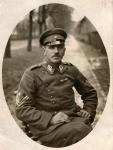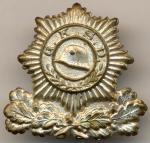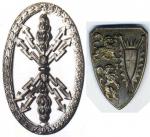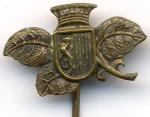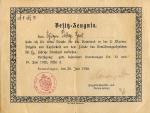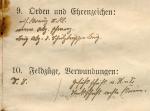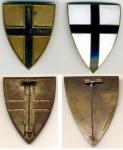
bolewts58
Active Contributor-
Posts
624 -
Joined
-
Last visited
-
Days Won
11
Content Type
Profiles
Forums
Blogs
Gallery
Events
Store
Everything posted by bolewts58
-
Uncategorised Ausweis Freikorps Pfeffer
bolewts58 replied to dedehansen's topic in Germany: Weimar Republic & Deutsche Freikorps
The stickpin was a silver Westphalian horse on an enameled black shield as shown in the upper corner of the ausweis. -
In my opinion, there's no chance that this Baltic Cross is real. After my initial question on WAF (link in Destruction's answer), I've seen a few of these and they all have roughly the same kind of finish and screw-back device. They are all likely made by Alexander Chichikalov, who makes a number of very high quality Freikorps copies.
-
New Schutzdivision Photo
bolewts58 replied to dante's topic in Germany: Weimar Republic & Deutsche Freikorps
The hand-writing is awful. It seems to be a greeting from someone's brother, as far as I can make out. Here's a card I have to the same unit. -
Actually, you're correct - GKSD. The other collar badge at the back of the collar is therefore likely Freikorps Schleswig-Holstein. The sleeve shield is for the Freiwillige Nachrichten-Truppen. It's possible that all 3 of these badges could be worn together. Rare combination of unit insignia. Too bad, the badges are not clearer.
-
Hi Claudio I'm happy I could help with the photo. It just took a little digging online. I was interested in this group, because of my interest in the Freikorps. I knew tha baron had been a major player early on in the Spartacist uprising and the border defence in Silesia (hence the Silesian Eagle). The photo just popped up when I was researching what he had done. cheers, Brian
-
Freikorps history. He formed Freiwilligen-Bataillons von Dalwigk on November 15, 1918, but left it on December 23 to take command of the III. Batl. 4. Niederschlesien Inft.-Regt. Nr. 51, which disbanded in March 1919. He earned the Silesian Eagle with swords and oakleaves while commanding Freiwilligen Husaren-Regt. 12., before moving to 10. Preuss. Reiter-Regt. in the Reichswehr in April 1920.
-
-
count over to the 9th bead on the obverse side, and you will see that it is noticeably larger than the rest.
-
Very nice skull array. I especially like the MWH shield, Danzig Skulls and the two Iron Division medals. Although, I wouldn't consider Wehrwolf to be Freikorps, strictly speaking. Here's a Military Pass to a guy who served in the east from 1914 to early 1919 doing defence duty in the Ukraine, from June-December 1918. He was awarded the Schutztruppe Bug Star, as noted in his pass. It's the only Freikorps award that recognized WWI service: i.e. in defence forces in the east after the Russian Revolution and treaty with Russia in 1917.
-
Silesian Eagles in wear
bolewts58 replied to TerryG's topic in Germany: Weimar Republic & Deutsche Freikorps
My guess on the armbadge is Prussian state police.

